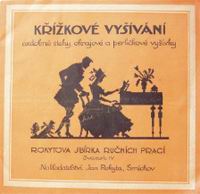Part one: Europe
Juraj Zajonc
Embroidery is considered to be one of the most developed and, regarding its patterns, the richest expression of traditional textile art in Europe. The historical secular and sacral, noble, bourgeois, town, folk and contemporary embroidery contains many motifs. Many of embroidery motifs and their full compositions have appeared in embroidery throughout the centuries. Printed and embroidered pattern books play an important and specific task in disseminating the information, hence providing for the continuous repetition or rediscovery of embroidery patterns. Pattern books were considered to start in Renaissance times and finish in Art Décor times. However, pattern books appeared before the sixteenth century and remained part of the development of decorative expression after the first part of the twentieth century. The oldest pattern book, dating from the beginning of the tenth century, is of French origin. Johann Siebmacher is considered to be the author of the pattern books that most impacted the motif scale of decorative traditions in Europe. In 1597 he published Schön Neue Modelbuch in Nuremberg; it was carved in copper, a technique which allowed more detailed pattern drawing. Some of the patterns are taken from older pattern books. Pattern books were published mainly in Germany, Italy and France, and also in England. The objective of pattern books published in the sixteenth century was to teach women how to sew, embroider and draw. They were intended for women – amateurs from higher society. From the nineteenth century, the importance of pattern books changed. Apart from patterns and motifs, a section was devoted to embroidery techniques. This teaching continually acquired larger importance as the development of artistic creation. From the end of the nineteenth century, the formal part of pattern books changed. Embroidery patterns, as well as examples of other handicraft techniques were often an addition to women’s fashion magazines. Germany maintained the leading position for publishing pattern books in the nineteenth and twentieth centuries. In 1886 Therese de Dillmont published an Encyclopaedia of female handicrafts, which was translated into 17 languages in its latter publications. It is the most basic and most complex encyclopaedia of hand textile techniques, which provides for educating generations of women about the wide scale of embroidery techniques. Interest in embroidery in Bohemia and Moravia in the second half of the nineteenth century was triggered by an overall European revival of hand textile production during the Secession. The impulse creating many of the pattern books was embroideries from Moravia, an area with the richest and most vivid embroidery traditions. Pattern books represent an important element of the continuous development of decorative traditions. Even though each one was created in a specific country and we usually know its author, the patterns have continually become a part of the overall European cultural heritage. Many of them are also part of motifs appearing in embroidery in Slovakia.
